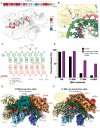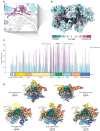Structural basis of a dual-function type II-B CRISPR-Cas9
- PMID: 40613710
- PMCID: PMC12231574
- DOI: 10.1093/nar/gkaf585
Structural basis of a dual-function type II-B CRISPR-Cas9
Abstract
Cas9 from Streptococcus pyogenes (SpCas9) revolutionized genome editing by enabling programmable DNA cleavage guided by an RNA. However, SpCas9 tolerates mismatches in the DNA-RNA duplex, which can lead to deleterious off-target editing. Here, we reveal that Cas9 from Francisella novicida (FnCas9) possesses a unique structural feature-the REC3 clamp-that underlies its intrinsic high-fidelity DNA targeting. Through kinetic and structural analyses, we show that the REC3 clamp forms critical contacts with the PAM-distal region of the R-loop, thereby imposing a novel checkpoint during enzyme activation. Notably, F. novicida encodes a noncanonical small CRISPR-associated RNA (scaRNA) that enables FnCas9 to repress an endogenous bacterial lipoprotein gene, subverting host immune detection. Structures of FnCas9 with scaRNA illustrate how partial R-loop complementarity hinders REC3 clamp docking and prevents cleavage in favor of transcriptional repression. The REC3 clamp is conserved across type II-B CRISPR-Cas9 systems, pointing to a potential path for engineering precise genome editors or developing novel antibacterial strategies. These findings reveal the molecular basis of heightened specificity and virulence enabled by FnCas9, with broad implications for biotechnology and therapeutic development.
© The Author(s) 2025. Published by Oxford University Press on behalf of Nucleic Acids Research.
Conflict of interest statement
None declared.
Figures






Update of
-
Structural basis for a dual-function type II-B CRISPR-Cas9.bioRxiv [Preprint]. 2025 Feb 11:2024.10.22.619592. doi: 10.1101/2024.10.22.619592. bioRxiv. 2025. Update in: Nucleic Acids Res. 2025 Jun 20;53(12):gkaf585. doi: 10.1093/nar/gkaf585. PMID: 39990493 Free PMC article. Updated. Preprint.
Similar articles
-
Structural basis for a dual-function type II-B CRISPR-Cas9.bioRxiv [Preprint]. 2025 Feb 11:2024.10.22.619592. doi: 10.1101/2024.10.22.619592. bioRxiv. 2025. Update in: Nucleic Acids Res. 2025 Jun 20;53(12):gkaf585. doi: 10.1093/nar/gkaf585. PMID: 39990493 Free PMC article. Updated. Preprint.
-
Rapid two-step target capture ensures efficient CRISPR-Cas9-guided genome editing.Mol Cell. 2025 May 1;85(9):1730-1742.e9. doi: 10.1016/j.molcel.2025.03.024. Epub 2025 Apr 23. Mol Cell. 2025. PMID: 40273916 Free PMC article.
-
Visualization of a multi-turnover Cas9 after product release.Nat Commun. 2025 Jul 1;16(1):5681. doi: 10.1038/s41467-025-60668-7. Nat Commun. 2025. PMID: 40593576 Free PMC article.
-
Artificial Intelligence in CRISPR-Cas Systems: A Review of Tool Applications.Methods Mol Biol. 2025;2952:243-257. doi: 10.1007/978-1-0716-4690-8_14. Methods Mol Biol. 2025. PMID: 40553337 Review.
-
Application of CHyMErA Cas9-Cas12a combinatorial genome-editing platform for genetic interaction mapping and gene fragment deletion screening.Nat Protoc. 2021 Oct;16(10):4722-4765. doi: 10.1038/s41596-021-00595-1. Epub 2021 Sep 10. Nat Protoc. 2021. PMID: 34508260 Free PMC article. Review.
References
MeSH terms
Substances
Supplementary concepts
Grants and funding
LinkOut - more resources
Full Text Sources
Miscellaneous

